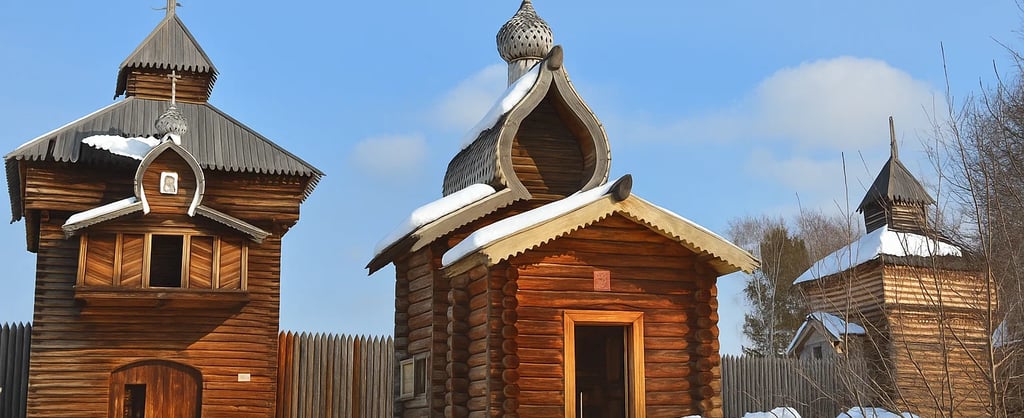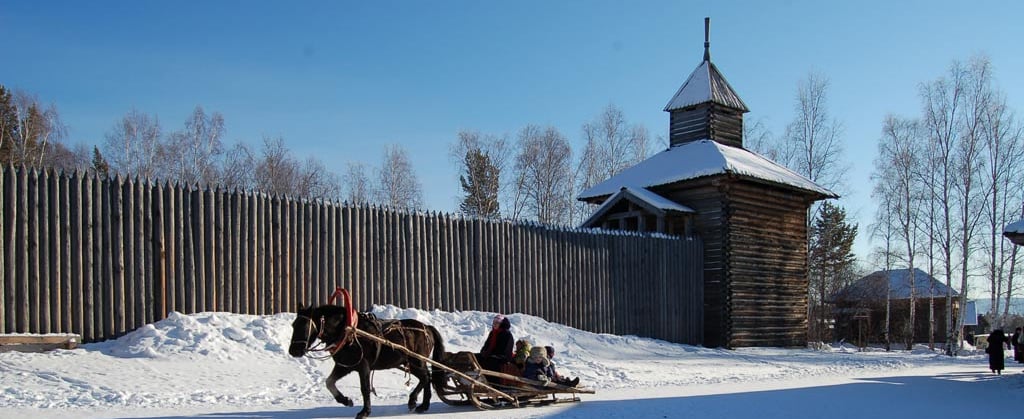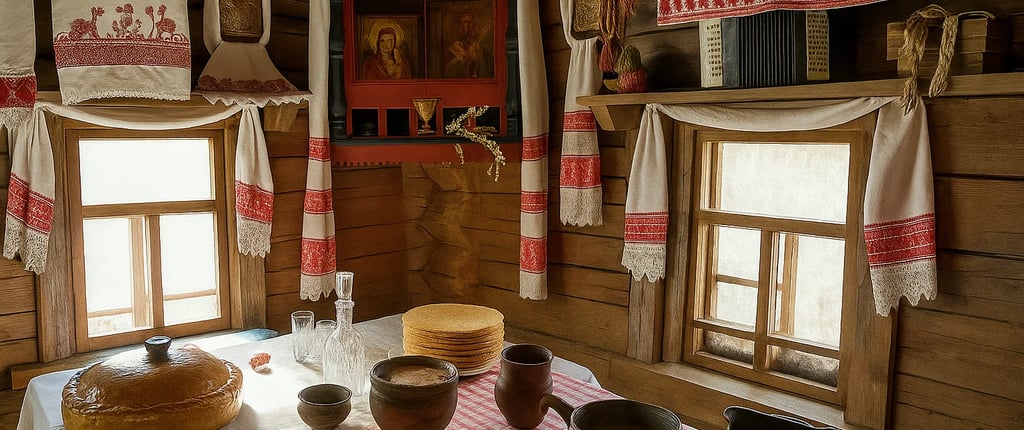Taltsy Museum: A Living Chronicle of Siberian Wood and Spirit
Nestled along the Angara River, this open-air museum brings Siberia’s wooden architecture and folk traditions to life with haunting authenticity.


Where the Angara Flows and Time Stands Still
Between the city of Irkutsk and the southern shores of Lake Baikal, where the Angara River winds its way through forested valleys, there lies a place where time seems to flow backward — or perhaps to stand entirely still.
This is the Taltsy Museum of Architecture and Ethnography, an open-air sanctuary where the wooden soul of Siberia lives on.
Here, amid towering pines and clear northern air, one walks not through reconstructed history, but through a world that breathes with the voices of artisans, peasants, exiles, and traders — those who shaped this vast land from log and earth, from faith and endurance.
A Museum Born of Rescue
The Taltsy Museum owes its existence to a great act of cultural rescue.
In the 1960s, Soviet engineers began the construction of the Ust-Ilimsk Hydroelectric Station, which would flood large areas of the Angara valley. Among the doomed lands lay numerous villages rich in traditional wooden architecture — churches, farmsteads, watchtowers, and homes built in styles that had evolved over centuries.
Recognizing the imminent loss of this priceless heritage, a group of historians and architects led by Anatoly Efimovich Medyntsev spearheaded a bold effort: to dismantle and relocate the most significant structures to a new site near Irkutsk.
In 1969, the Taltsy Museum was founded on a forested slope above the Angara, where today it spans more than 67 hectares, preserving not just buildings, but a way of life.
A Village Woven from Memory
To enter Taltsy is to step into a living tapestry of Siberian settlement. The museum is not organized as a static display but as a recreated village, where structures stand as they once did — not behind glass, but under sun and snow, wind and cloud.
One wanders freely among log churches whose crosses rise above the trees, peasant farmsteads with carved window frames and kitchen gardens, watchtowers that once guarded the frontiers of empire, and workshops alive with the textures of wood, felt, and iron.
The layout reflects the historical realities of settlement along the Angara and Baikal regions, where Russian colonists, Buryat herders, Evenk hunters, and Old Believer exiles shaped a landscape of remarkable cultural diversity.
The Wooden Soul of Siberia
At the heart of Taltsy is the genius of wood — the material that defines Siberian life.
In a land of vast forests and long winters, wood was not merely material but a kind of second nature. It built homes, churches, fortifications, tools, furniture, even utensils and toys.
The museum’s buildings showcase the astonishing variety of wooden craftsmanship:
Logs joined with complex dovetail notches, forming structures that could last for centuries.
Intricately carved window surrounds and porch columns, blending folk art with architectural function.
Soaring onion-domed chapels assembled without a single nail, their timber held together by wooden pegs and cunning joinery.
Here, one comes to understand that Siberian wooden architecture was not primitive but profoundly adapted to climate, landscape, and belief — an art born of necessity and shaped by beauty.
A Tapestry of Cultures
Taltsy’s genius lies not only in its preservation of Russian peasant life, but in its celebration of Siberia’s cultural mosaic.
The museum includes reconstructed Evenk hunting camps, with conical skin tents, sleds, and tools that evoke a life of seasonal movement across tundra and taiga.
Buryat yurts stand nearby, their lattice walls and felt coverings revealing the enduring genius of nomadic architecture.
Elsewhere, one finds homes of the Old Believers — communities that fled religious persecution in European Russia, bringing with them a rich heritage of icon painting, embroidery, and domestic ritual.
These juxtapositions allow visitors to glimpse the extraordinary diversity of Siberian experience — not as isolated fragments, but as a living whole.
Practical Information
Location
Taltsy Museum of Architecture and Ethnography
81st km of the Baikal Highway (M55), Irkutsk Oblast, Russia
The museum is located approximately 47 km from Irkutsk and about 20 km from Listvyanka on the way to Lake Baikal.
Opening Hours
Daily: 10:00 – 18:00
During summer season: extended hours may apply.
Closed on certain public holidays; check ahead during winter months.
Admission
General admission: moderate fee (varies seasonally).
Discounts available for students, children, pensioners.
Separate fees may apply for special workshops, festival days, and guided tours.
Getting There
By car: Easy drive from Irkutsk on the Baikal Highway; ample parking available.
By public transport: Regular buses and minibuses (marshrutkas) run from Irkutsk bus station to Taltsy, especially in summer.
By tour: Many Irkutsk-based tours to Lake Baikal include a stop at Taltsy — highly recommended for first-time visitors.
Facilities and Services
Cafés and teahouses offering traditional Russian fare and Siberian specialties.
Souvenir shops selling locally made crafts and textiles.
Rest areas and picnic spots within the museum grounds.
Guided tours available in Russian; English-language guides can be arranged in advance.
The museum grounds are partially accessible; note that some historic structures may require stair climbing or uneven paths.
Events
Maslenitsa Festival (early spring): folk performances, games, and traditional crafts.
Summer crafts fairs and harvest festivals.
Winter festivities with sleigh rides and seasonal workshops.
Year-round educational workshops for children and adults.
Official Website
http://taltsy.ru
(Currently available primarily in Russian; many local tour agencies also provide English-language details.)


The Cycle of Village Life
The Taltsy Museum is more than an architectural showcase — it is a living portrait of traditional Siberian village life.
Throughout the year, the museum hosts seasonal festivals that breathe life into its wooden streets and courtyards. During Maslenitsa, the joyous Russian festival of spring, bonfires blaze beneath snowy trees, pancakes sizzle on griddles, and villagers in traditional costume enact ancient rites of farewell to winter.
At harvest time, the museum echoes with the rhythms of folk music and the scent of fresh-baked bread. Craft fairs fill the lanes with the work of potters, weavers, woodcarvers, and blacksmiths, keeping alive the skills that once sustained village economies.
Visitors are invited not merely to watch but to participate — to learn a dance, shape a pot, or join a procession. In these moments, Taltsy becomes what it was always meant to be: a place where heritage is not displayed but lived.
Education and Preservation
The museum also serves as a vital center for education and preservation.
Its curators and artisans work tirelessly to document and revive traditional building techniques, many of which risk being lost as modern materials and methods supplant the old ways. Workshops in wood carving, icon painting, and folk crafts are regularly held for both children and adults, ensuring that the knowledge of the hand is passed to new generations.
Scholars from across Russia and beyond come to study the museum’s extensive ethnographic collections, which include tools, garments, religious objects, and domestic artifacts from across Siberia’s many cultures.
In this way, Taltsy functions not only as a tourist attraction but as a living archive, a repository of knowledge whose value grows with each passing year.
The Visitor’s Experience
To visit the Taltsy Museum is to embark on a journey through time and space.
One might begin in the shadow of a towering watchtower, imagining the frontier life of Cossack settlers. A short walk brings one to the serene interior of a log church, its icons glowing softly amid the scent of aged pine.
Farther on, the soft tread of felted boots leads one into a Buryat yurt, where the hearth remains the center of life. Beyond, a cluster of peasant homes opens its doors to reveal woven cloth, polished samovars, and well-worn looms.
Children play with traditional wooden toys; elders explain the uses of ancient tools; the air hums with stories. In this space, the past is not a distant abstraction but a palpable presence — one that welcomes each visitor into its embrace.




